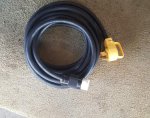Your loads would be additive. If one appliance starts and runs drawing current and creating a voltage drop, then another kicks in and draws more current and creates more voltage drop, then another, and another the end result could be catastrophic if your wire size feeding the devices is too small.
You need to consider total current requirement and size the feed for the distance to the load to eliminate voltage drop. And its never a good idea to operate on the edge of capacities.
I don't post much in this arena. Its not what I know best. Too many other smart guys out there, so I just don't do it.
So, why am I here? Well, I follow everything generator wise, just to be able to do just this. At the end of the day, the whole thing rotates around
You need to consider total current requirement. Everyone repeats it, over and over again, but not everyone "Gets it".
Everything about a house hook up hinges on this fact. Everything. Its the very first thing anyone tosses out in these threads. You simply can not figure gen set size, wire size AND length, hook up gear, safety gear and on and on, until you figure TOTAL current requirement. And then toss on a SAFETY SWAG!!! As has been mentioned, its not good to operate on the edge of the envelope.
Why don't you guys set down and write something for new guys. A guide to this many legged animal, "House Hook Up made simple, 101".








